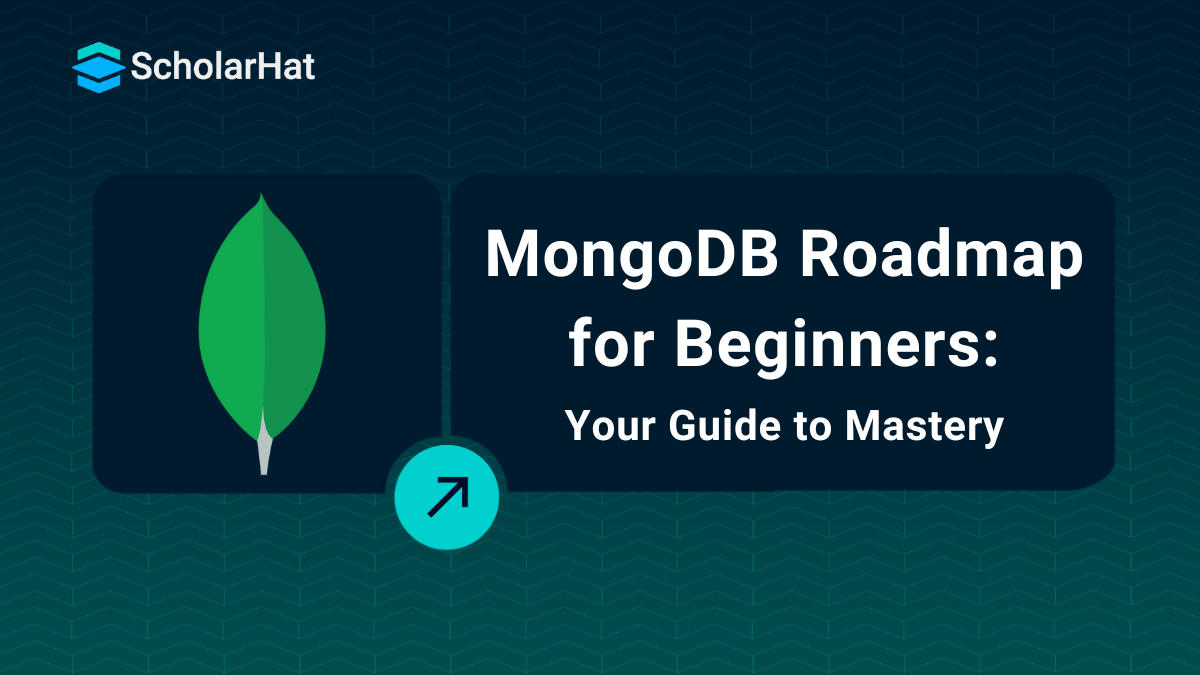21
NovMongoDB Roadmap for Beginners
MongoDB Roadmap: An Overview
The MongoDB Roadmap is a complete instructional guide for the well-known NoSQL database MongoDB. Databases and collections are covered first, followed by a deep dive into data querying and manipulation (CRUD operations). It also has security, indexing, and aggregation functions, as well as scaling through replication and sharding.
For learners aiming to validate their skills, exploring a MongoDB Certification Free program can be a great way to gain credibility without incurring costs.
What is MongoDB?
An open-source NoSQL database management system is called MongoDB. Conventional relational databases are being replaced with NoSQL (not only SQL). NoSQL databases can be handy when handling big, dispersed data sets. MongoDB is a tool for managing, storing, and retrieving document-oriented data.
High-volume data storage is facilitated by MongoDB, which enables businesses to store vast volumes of data quickly. Ad hoc queries, indexing, load balancing, aggregation, server-side JavaScript execution, and other features are some of the other reasons why businesses utilize MongoDB.

When to use MongoDB?
MongoDB is a general-purpose database that supports applications in a variety of industries (including telecommunications, gaming, finance, healthcare, and retail). MongoDB has found a home in a variety of industries and functions because it addresses long-standing issues in data management and software development. Typical MongoDB usage scenarios include:
- MongoDB excels in integrating several data sources, resulting in an overall view where other databases fail.
- Its document approach supports increasingly sophisticated data structures and formats such as geographical, ensuring robustness without ongoing redesign.
- MongoDB's scale-out architecture allows it to easily manage high-performance applications while also supporting hybrid and multi-cloud deployments via MongoDB Atlas.
- Developers have control over data, promoting agile development and collaboration while allowing for flexible data structure evolution.
Who uses MongoDB?
In today's IT company, many firms use MongoDB as a database service for their applications or data storage systems. According to Siftery's MongoDB survey, over 4000+ companies are aware that they use MongoDB as a database. Some of the key names include:
- Castlight Health
- IBM
- Citrix
- T-Mobile
- Zendesk
- Sony
- BrightRoll
- Foursquare
- HTC
- InVision
- Intercom etc.
| Read More: Top 50 MongoDB Interview Questions and Answers |
Why MongoDB?
- The document data model is an effective method for storing and retrieving data in any modern computer language, allowing developers to work rapidly.
- MongoDB is offered in any major public cloud (such as AWS, Azure, and Google Cloud) via MongoDB Atlas, in big data centers via the Enterprise Advanced edition, or for free via the open-source Community edition.
- MongoDB provides an excellent user experience for developers, who can install it and write code instantly.
- MongoDB's horizontal scale-out architecture can handle massive amounts of data and traffic.
- MongoDB has established a huge and sophisticated platform ecosystem. It includes a global network of developers and consultants, making it simple to find assistance. It also offers enterprise-grade support.
Advantages of MongoDB
- MongoDB is a document database that does not use schemas.
- MongoDB supports field-based queries, range-based queries, regular expressions (regex), and other methods for searching stored data.
- MongoDB is relatively simple to scale up and down.
- MongoDB mostly uses internal RAM for storing working temporary datasets, which is significantly faster.
- MongoDB allows primary and secondary indexing on any field.
- MongoDB allows database replication.
- Sharding allows us to implement load balancing in MongoDB. It uses sharding to horizontally grow the database.
- MongoDB can be used as a file storage system, also known as GridFS.
- MongoDB supports a variety of data aggregation processes, including aggregation pipelines, map reduction, and single-goal aggregation commands.
- MongoDB can store any sort of file, of any size, without affecting our stack.
- MongoDB mostly uses JavaScript objects in place of procedures.
- MongoDB supports special collection types such as TTL (Time-To-Live) for data storage that expires at a specific time.
- The dynamic database schema used in MongoDB is called BSON.
What is MongoDB Atlas?
MongoDB Atlas is a multi-cloud database service created by the same team that built MongoDB. Atlas simplifies database deployment and management while providing the flexibility required to construct durable and performant global applications on the cloud providers of your choice.
MongoDB Atlas is a managed cloud database that simplifies deployment, management, and recovery across many cloud service providers (AWS, Azure, and GCP). MongoDB Atlas is the most effective way to deploy, run, and scale MongoDB in the cloud.

What is SQL?
SQL (Structured Query Language) is a programming language used to handle data in relational databases, which contain structured data in tables. Its syntax is simple to understand, so even if you're new to programming, you can pick it up quickly. It's also useful in non-technical fields.
What is NoSQL?
NoSQL databases (sometimes known as "not only SQL") are non-tabular databases that store data differently than relational tables. Depending on the data model, NoSQL databases are classified into several categories. The primary types are document, key-value, wide-column, and graph. They offer flexible schemas and can readily scale to handle large amounts of data and significant user traffic.
SQL vs. NoSQL
| Features | SQL | NoSQL |
| Stands for | Structured Query Language | Not Only SQL |
| Database Management System | Relational database management system (RDBMS) | Non-relational database management system |
| Suitable for | Structured data with a predetermined schema | Data that is unstructured or semi-structured |
| Data Storage | Tables with columns and rows were used to store the data | Documents or collections are used for storage |
| Transaction Management | Follows the ACID properties (atomicity, consistency, isolation, and durability) | Does not always follow ACID characteristics |
| Queries | It supports JOINs and complex queries | Does not support joins or complex queries |
| Data Structure | Uses a normalized data structure | Uses a denormalized data structure |
| Scaling | Vertical scaling is required to manage massive volumes of data | Horizontal scaling can be used to handle massive amounts of data |
| Examples | MySQL, PostgreSQL, Oracle, SQL Server, Microsoft SQL Server | MongoDB, Cassandra, Couchbase, Amazon DynamoDB, Redis |
Setting up MongoDB
- Installation: Download and install MongoDB on your local PC by your operating system's instructions.
- Configuration: Using the mongod.conf file, you may understand and customize MongoDB parameters such as data and log directories, and network interfaces.
- Start MongoDB: Use the mongod command to launch MongoDB as a standalone, replica set, or sharded cluster.
- Client Tools: Use MongoDB Shell (mongo) and MongoDB Compass to connect to MongoDB instances and perform basic operations.
- Data Import/Export: Use mongoimport to import data from JSON, CSV, or BSON files, and mongoexport to export data from MongoDB collections.
MongoDB Shell
- Learn how to connect to a MongoDB instance with the MongoDB Shell.
- Learn how to navigate databases and collections in the MongoDB Shell.
- Practice using Shell commands to insert, query, update, and delete documents in MongoDB collections.
- Learn how to create and manage indexes for better query performance.
- Discover MongoDB's aggregation framework, which allows you to do complicated data aggregations.
- Learn how to authenticate and authorize users in MongoDB for safe access to databases and collections.
- Understand how to use the MongoDB Shell to create scripts that automate processes or execute batch operations.
- Develop your ability to identify and resolve mistakes while working with MongoDB Shell commands.
Database Skills
Data models, Data Schemas, and Data Independence
- Learn about many types of data models, including relational, document-oriented, key-value, and graph models.
- Understand how each model's data is organized, stored, and retrieved.
- Gain experience developing data schemas that are tailored to specific use cases and application needs.
- Understand the concepts of denormalization, embedding vs. referencing, and schema validation in MongoDB.
- Discover how to organize documents efficiently to describe complicated data relationships and hierarchies.
- Understand how to represent data entities using hierarchical documents, arrays, and references.
- Use MongoDB's schema validation capability to impose data integrity restrictions and assure consistency in document structures.
- Learn how to create validation rules that check incoming data against preset schemas.
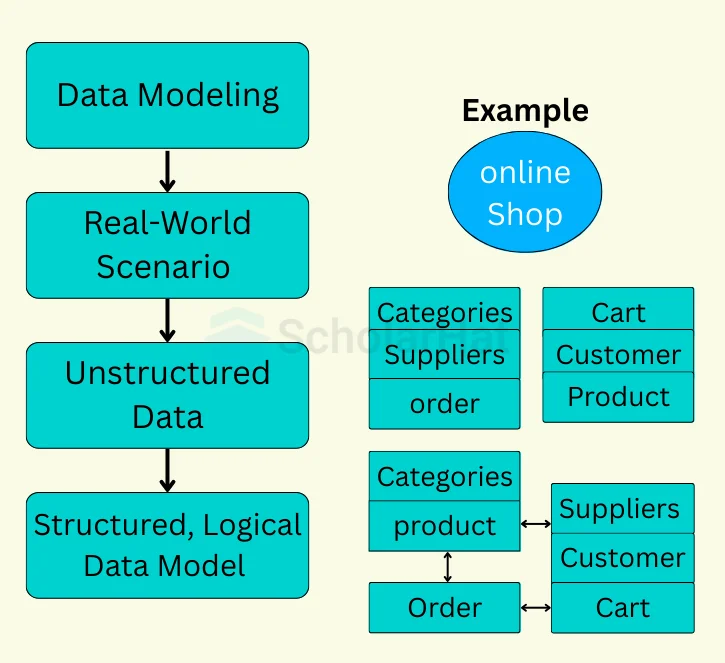
Relational Model and Entity-Relationship Model
- Learn about the relational model's essential concepts, such as tables (relations), rows (tuples), columns (attributes), keys, and table-to-table interactions.
- Discover how to use ER diagrams to represent real-world items, their attributes, and relationships.
- Understand entity types, properties, main and foreign keys, and cardinality limitations.
- Study how normalization works in relational databases to minimize redundancy and improve data integrity.
- Learn about the various normal forms (1NF, 2NF, and 3NF) and how to use normalization techniques to improve database schema design.
- Explore recommended practices for creating relational database schemas.
Normalization, Joins, SQL & NoSQL
- Understand the principles of normalization in relational databases, including the several normal forms (1NF, 2NF, 3NF).
- Learn how normalization organizes data into well-structured tables, reducing redundancy and improving data integrity.
- Explore denormalization techniques in NoSQL databases such as MongoDB to improve read efficiency and streamline query processes.
- Understand whether to denormalize data and the trade-offs between data redundancy and complexity.
- Learn about the many types of joins (e.g., inner join, outer join) in relational databases and how they aggregate data from numerous tables using common columns.
- Study how MongoDB's document-oriented model handles relationships without traditional joins.
- Learn Structured Query Language (SQL), which is used to query and manipulate data in relational databases.
- Master the basics of SQL commands (SELECT, INSERT, UPDATE, and DELETE), as well as how to do joins, filtering, sorting, and aggregation.
- Understand the principles and features of NoSQL databases, such as schema flexibility, horizontal scalability, and support for semi-structured and unstructured data.
- Learn about the many types of NoSQL databases (document, key-value, columnar, and graph) and their application scenarios.
Indexing, Hashing, Transaction & Concurrency
- Understand the significance of indexing in MongoDB for improving query performance.
- Learn about the many types of indexes (e.g., single field, compound, multi-key) and how to create and manage them to reduce query execution time.
- Explore hashing algorithms and applications in MongoDB, such as hash indexes.
- Know how hashing can be used to improve data retrieval and storage, particularly for huge datasets or high-speed lookups.
- Study MongoDB's transaction management and support for multi-document transactions.
- Get familiar with the ACID (Atomicity, Consistency, Isolation, and Durability) attributes and how transactions assure data integrity and consistency in MongoDB deployments.
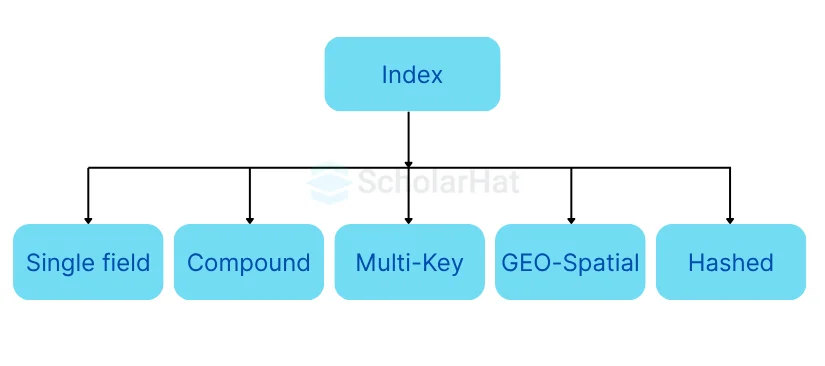
Database Design & Tools
- Understand how these tools work with MongoDB, including functionality for creating MongoDB schemas, visualizing document structures, and conducting data modeling tasks.
- Moon Modeler: Explore Moon Modeller for visual database design and ER modeling.
- DBeaver: Learn about DBeaver's database administration, SQL querying, and data visualization capabilities.
- Adminer: Understand how to utilize Adminer, a lightweight database management tool that supports a variety of database systems, including MongoDB.
- Aqua Data Studio Entity Relationship Modeler: Use Aqua Data Studio to create ER models and visual database designs.
- DbSchema: Explore DbSchema for visual database design, SQL creation, and schema documentation.
- ER/Studio: Discover ER/Studio for enterprise-level data modeling, collaboration, and metadata management.
- Hackolade: Learn how to use Hackolade for schema creation and data modeling in NoSQL databases like MongoDB.
Database Drivers
- MongoDB Native Driver: Discover how to utilize the MongoDB Native Driver, which provides a low-level interface for interacting with MongoDB databases directly from computer languages like Node.js, Python, Java, and others.
- Mongoose: Master Mongoose, the popular Object-Document Mapping (ODM) module for MongoDB in Node.js applications. Learn how to use Mongoose's straightforward API to construct schemas, models, and relationships, as well as conduct CRUD tasks.

- Mongoskin: Discover Mongoskin, a MongoDB driver for Node.js that provides a thin wrapper around the MongoDB Native Driver. Learn how to interface with MongoDB databases using Mongoskin's simpler, more expressive API.
- MongoJS: Learn how to utilize the MongoDB driver for Node.js, which tries to give a MongoDB-like API with more JavaScript-friendly syntax. MongoJS allows you to perform CRUD actions and execute MongoDB queries.
GUI Client Tools
- NoSQL Booster: Discover NoSQL Booster, a robust MongoDB GUI tool for Windows, macOS, and Linux. NoSQL Booster's user-friendly interface teaches you how to accomplish operations like querying, modifying documents, and managing indexes.
- Studio 3T: Familiarise yourself with Studio 3T, an all-in-one MongoDB GUI and IDE with advanced features like SQL query conversion, schema visualization, and data import/export. Learn how to use Studio 3T to do database development and management tasks.
- Robo 3T: Learn how to use Robo 3T (previously Robomongo), a lightweight MongoDB GUI tool with fundamental functionality for querying, modifying documents, and database management. Discover Robo 3T's simplicity and ease of use for MongoDB developers.
- MongoDB Compass: Discover MongoDB Compass, the official GUI tool supplied by MongoDB Inc. Discover how to use the user-friendly interface of MongoDB Compass to design geographic queries, analyze performance, and graphically examine data.
- Mongo Management Studio: Learn about Mongo Management Studio, a comprehensive MongoDB GUI application that includes capabilities like schema visualization, data modeling, performance monitoring, and user management. Learn how to utilize Mongo Management Studio for database administration.
- MongoDB Monitoring Tool: Understand how to use the MongoDB Monitoring Tool to monitor and manage MongoDB deployments. Discover features like real-time performance analytics, alerting, and automated scaling to improve MongoDB database performance and availability.
- NoSQL Manager: Discover NoSQL Manager, a powerful MongoDB GUI tool for database building and administration. The wide feature set of NoSQL Manager enables you to execute activities such as data import/export, schema validation, and query optimization.
MongoDB Core Concepts
Database
- Learn how to construct MongoDB databases with the use of commands or through client libraries.
- Explore how to switch between databases in MongoDB using the use command.
- Understand that MongoDB supports numerous databases inside a single instance.
- Explore ways to list databases in MongoDB, such as using the show dbs command or navigating to the databases collection in the admin database.
- Study how to drop databases in MongoDB using the dropDatabase() method or the db.dropDatabase() command in the MongoDB Shell.
CRUD Operations
Create:
- Discover how to insert documents into MongoDB collections using the insertOne() and insertMany() methods.
- Understand the document structure and data types provided by MongoDB.
- Consider possibilities for adding documents with specific _id values or executing bulk inserts to increase performance.
Read
- Learn how to query MongoDB collections using find() and findOne().
- Understand the query operators used to filter, sort, limit, and skip results.
- Use projection to extract only specified fields from documents.
- Learn about cursor methods for iterating over query results and retrieving documents.
Update:
- Discover how to update documents in MongoDB collections with methods such as updateOne() and updateMany().
- Understand the update operators $set, $unset, $inc, $push, and $pull.
- Explore alternatives for upserts to insert documents that do not already exist, as well as atomic processes to ensure consistency.
Delete
- Learn how to delete documents from MongoDB collections with methods such as deleteOne() and deleteMany().
- Learn about deletion strategies, including eliminating individual documents, multiple documents, or all documents that meet a query.
Aggregation
- Understand MongoDB's aggregation pipeline.
- Learn how to alter and analyze data with stages like $match, $group, $project, $sort, $limit, and $lookup.
- Study the order of stages in the pipeline and how documents progress through each level.
- Understand popular aggregation operators such as $sum, $avg, $max, $min, $count, $unwind, and $addToSet.
Data Model
- Understand the concept of documents in MongoDB, including their flexible schema.
- Study how to format data as JSON-like documents with key-value pairs.
- Learn about the different data types that MongoDB supports, including string, number, boolean, date, array, object, and binary.
- Discover expanded JSON and BSON data formats for describing specialized data structures.
Transaction & Atomicity
- Understand the concept of transactions and its importance in ensuring data consistency and integrity.
- Learn about the ACID qualities (Atomicity, Consistency, Isolation, and Durability) and how transactions maintain them in database operations.
- Discover MongoDB's support for multi-document transactions, which was added in version 4.0.
- Study how transactions enable atomic operations on many documents and collections within a single MongoDB instance.
- Explore how to initiate, commit, and abort transactions in MongoDB using the startSession(), commitTransaction(), and abortTransaction() functions.
- Know the various isolation levels allowed by MongoDB transactions, including snapshot, readCommitted, and readUncommitted.
- Find out about the error handling mechanisms in MongoDB transactions, such as transaction aborts and rollbacks.
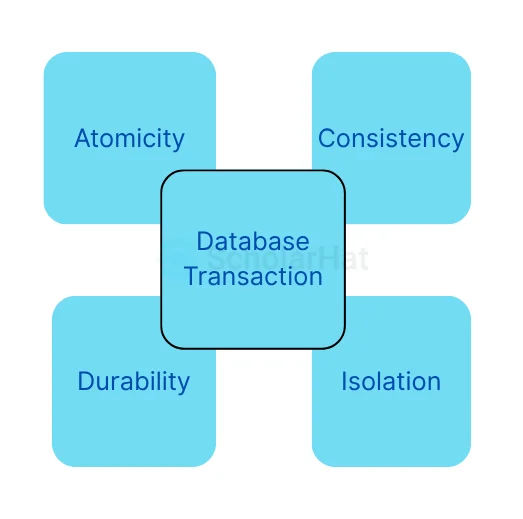
Indexes
- Understand the purpose and significance of indexes in MongoDB for improving query performance.
- Learn how indexes speed up query performance by allowing MongoDB to swiftly discover and retrieve documents.
- Explore the many index types provided by MongoDB, such as single field indexes, compound indexes, multikey indexes, text indexes, geospatial indexes, and hashed indexes.
- Know the features and applications of each index type.
- Find out how to create indexes in MongoDB with the createIndex() or ensureIndex() methods.
- Understand how to specify index keys, options, and features like uniqueness and sparse indexes.
Replication
- Understand the concept of MongoDB replication and its importance in terms of high availability and redundancy.
- Learn how replication works by storing several copies of data on multiple nodes in a MongoDB replica set.
- Find out how to configure and deploy MongoDB replica sets, which are made up of numerous MongoDB instances (nodes) arranged in a primary-secondary architecture.
- Study MongoDB's replication system and the techniques for synchronizing data changes among replica set members.
- Understand how primary nodes duplicate write operations (oplog) to secondary nodes to ensure eventual consistency.
Sharding
- Understand the concept of sharding in MongoDB and how it affects horizontal scalability and data distribution among nodes.
- Learn how sharding allows MongoDB to handle huge datasets with excellent speed by separating data into smaller bits known as shards.
- Explore the concept of the shard key, which governs how data is distributed among shards in a sharded cluster.
- Study how shard key selection affects data distribution, query performance, and cluster scalability.
- Learn about the architecture of a MongoDB sharded cluster, which is made up of several components such as configuration servers, shard servers, and query routers.
Storage
- Understand the concept of MongoDB storage engines, including WiredTiger and MMAPv1.
- Know the differences between storage engines in terms of performance, scalability, and functionality.
- Explore how data is saved in MongoDB using data files, which comprise data files, journal files, and diagnostic files.
- Study the file structure and organization in MongoDB's data directory.
- Find out about MongoDB's storage allocation algorithms, including how it allocates disc space for collections, indexes, and other data structures.
- Know how to monitor storage, performance metrics, and disc space utilization in MongoDB systems.
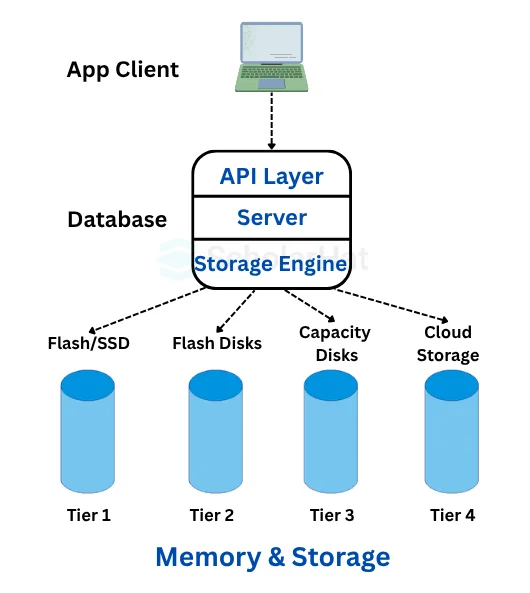
Operators
- Understand MongoDB's extensive collection of query operators for querying and filtering documents.
- Learn about the following operators: comparison ($eq, $ne, $lt, $lte, $gt, $gte), logical ($and, $or, $not), element ($exists, $type), and array ($in, $nin, $all, $elemMatch).
- Discover MongoDB's update operators for updating documents in collections.
- Understand atomic update operators like $set, $unset, $inc, $push, $pull, $addToSet, $pop, and $currentDate.
- Learn MongoDB's array operators, which allow you to query and manipulate arrays within documents.
- Study the array update operators ($push, $addToSet, $pull, $pop, $each) and array query operators ($elemMatch, $size, $all).
- Learn MongoDB's aggregation operators for data transformation and analysis.
- Explore pipeline operators ($match, $group, $project, $sort, $limit, $skip), arithmetic operators ($add, $subtract, $multiply, $divide), and array operators ($arrayElemAt, $filter, $map), among others.
- Understand MongoDB's text search operators to do full-text searches.
- Master how to customize text search with the $text operator and its associated operators ($search, $language, $caseSensitive, and $diacriticSensitive).
- Explore MongoDB's geospatial operators for searching and manipulating spatial data.
- Discover the following operators: $geoNear, $geoWithin, $geoIntersects, $near, $nearSphere, $box, $ center, $centerSphere, and $polygon.
- Know MongoDB's bitwise operators, which let you execute bitwise operations on integers.
- Learn about the operators $bitsAllClear, $bitsAllSet, $bitsAnyClear, and $bitsAnySet.
Security
- Understand how authentication in MongoDB controls access to databases and collections.
- Learn about MongoDB's authentication protocols, which include SCRAM-SHA-256, X.509 certificates, LDAP, and Kerberos.
- Explore MongoDB's role-based access control (RBAC) scheme for authorization.
- Discover how to create roles with specified permissions (read, write, databaseAdmin, userAdmin, and so on) and assign them to users or applications.
- Study how to manage users in MongoDB, including adding users, altering user roles and privileges, and deleting them.
- Learn about MongoDB's encryption features for securing data at rest and in transit.
- Recognize the significance of auditing in MongoDB for tracking and monitoring user actions and security-related events.
- Understand how to set up MongoDB to listen on specified network interfaces, ports, and IP addresses.
Working with Documents
- Understand the structure of MongoDB documents, which are JSON-like data structures made up of key-value pairs.
- Explore MongoDB's query language for getting documents from collections using precise criteria.
- Learn how to edit existing documents in MongoDB collections with update operators like $set, $unset, $inc, $push, and $pull.
- Master how to delete documents from MongoDB collections by calling the deleteOne() and deleteMany() functions.
- Look at document validation in MongoDB to enforce data integrity constraints.
MongoDB Hosting
- Understand the process of deploying and managing MongoDB instances on their infrastructure.
- Learn how to install, configure, monitor, and maintain MongoDB on servers or cloud platforms such as AWS, Digital Ocean, and Microsoft Azure.
- Consider hosting MongoDB on major cloud platforms such as AWS, Digital Ocean, and Microsoft Azure.
- Study how to deploy MongoDB instances on these providers' virtual machines (EC2, Droplets, and VMs), as well as how to configure networking, security, and storage.
- Understand managed MongoDB hosting solutions, which simplify deployment and management.
- Know about MongoDB Atlas, mLab, Clever Cloud, Compose, and ObjectRocket, which offer managed MongoDB instances with automated backups, scalability, and monitoring.
- Explore MongoDB Atlas, the company's official managed hosting platform.
- Learn about mLab's capabilities, which include automated backups, scaling choices, and monitoring tools.
- Know Clever Cloud's platform for hosting applications and databases, including MongoDB.
- Learn about Compose's capabilities, including automated backups, scaling, and high-availability settings.
- Get to know Object Rocket's managed MongoDB hosting solution, which enables high-performance MongoDB deployments.
JSON
- Learn how MongoDB documents are represented in JSON format.
- Understand how to create and manipulate MongoDB documents with JSON syntax.
- Explore the data types supported by JSON and MongoDB, including string, number, boolean, array, object, and null.
- Know the structure of MongoDB documents in JSON format, including field names and values.
- Explore how to describe nested documents and arrays in MongoDB documents using JSON syntax.
- Learn how to query MongoDB collections with JSON-like query syntax.
- Get acquainted with how to serialize MongoDB documents into JSON format for storage or transfer.
- Study how to integrate MongoDB with apps that use the JSON data format.
BSON
- Understand BSON as the binary-encoded serialization format that MongoDB uses to store and transfer data.
- Explore the data types offered by BSON, which include standard kinds like string, number, boolean, array, object, and null, as well as unique types like ObjectId, Date, Binary, and Decimal128.
- Learn how BSON data types correspond to JSON data types and how they are expressed in binary form.
- Know BSON documents' binary structure, which includes field names, types, and values.
- Study how BSON's binary encoding improves the efficiency and compactness of data storage in MongoDB.
- Explore how MongoDB's query and manipulation operations work with BSON data.
Mongoose
Introduction to Mongoose
- Think of Mongoose as a Node.js and MongoDB Object Data Modelling (ODM) library.
- Learn about the features and advantages of using Mongoose to connect with MongoDB databases.
- Understand how to make Mongoose models, which describe MongoDB collections and give a way to query and manipulate documents.
- Study how to connect to MongoDB using Mongoose.
- Explore Mongoose's techniques for generating, reading, modifying, and removing documents, including create, find, findOne, update, and delete.
- Know about Mongoose's query-building features for filtering, sorting, and aggregating MongoDB documents.
- Understand Mongoose's validation features for enforcing data integrity constraints.
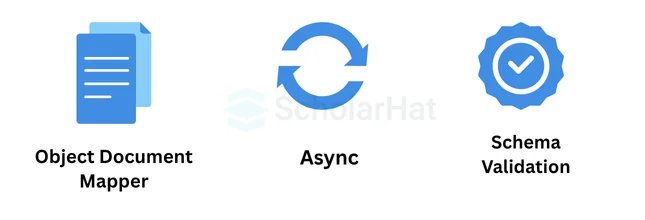
Mongoose Schema Types
- Understand the many schema types supported by Mongoose, such as String, Number, Date, Boolean, ObjectId, Array, and others.
- Learn how to create schema types and their options (such as needed, default values, and validation rules) for representing various data fields in MongoDB documents.
Mongoose Create Operation
- Learn how to use Mongoose to create new documents in your MongoDB collections.
- Understand how to use the Model.create() method to insert one or more documents into a Mongoose schema-based collection.
Mongoose Retrieve Operation
- Become proficient at obtaining documents from MongoDB collections using Mongoose.
- Learn about query techniques such as Model.find() and Model.findOne(), which are used to get documents based on certain criteria.
Mongoose Update Operations
- Learn how to update existing documents in MongoDB collections with Mongoose.
- Understand Mongoose's update methods, such as Model.updateOne(), Model.updateMany(), and Model.findOneAndUpdate(), and how to use them to edit document fields based on query criteria.
Mongoose Delete Operation
- Learn how to delete documents from MongoDB collections with Mongoose.
- Understand Mongoose's delete methods, such as Model.deleteOne(), Model.deleteMany(), and Model.findOneAndDelete(), and how they are used to remove documents depending on query criteria.
MongoDB Applications & Projects
- Healthcare Applications: MongoDB is commonly used in healthcare applications to store EHRs, medical imaging data, and patient information. Its scalability, adaptability, and adherence to industry rules make it ideal for healthcare applications.
- Geospatial Applications: Geospatial applications use MongoDB's functionality for location-based services like mapping, routing, and geofencing. It allows developers to store and query geographical data efficiently.
- Social Networking Sites: MongoDB is perfect for creating social networking sites that handle massive volumes of data, including posts, comments, likes, and messages. Its scalability and performance make it an attractive option for such platforms.
- Content Management Systems (CMS): MongoDB serves as a backend database for content management systems, enabling efficient storage and management of numerous sorts of material, including articles, photographs, and videos.
- E-commerce Platforms: E-commerce platforms use MongoDB to manage product catalogs, user profiles, order management, and inventory tracking. Its adaptable structure enables easy change and expansion as the platform grows.
- Real-time Analytics: MongoDB is suitable for real-time analytics, requiring rapid processing and analysis of enormous amounts of data. It allows organizations to derive important insights from their data in real-time.
Summary
The MongoDB Roadmap provides a complete overview of MongoDB, including database principles, querying, security, and scalability. MongoDB, an open-source NoSQL database management system, is popular due to its ability to handle massive, heterogeneous datasets efficiently. Because of its versatility and scalability, it has applications in a variety of areas, including healthcare, banking, and social media.
Beginners can start with a MongoDB Free Course to quickly build foundational knowledge and hands-on skills.
Take our Mongodb skill challenge to evaluate yourself!

In less than 5 minutes, with our skill challenge, you can identify your knowledge gaps and strengths in a given skill.

